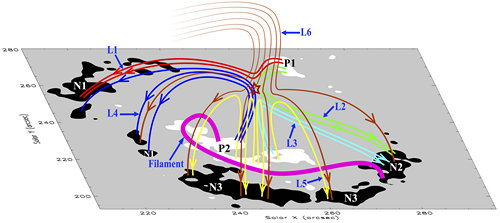Chinese Solar Telescope Reveals Acceleration of Magnetic Reconnection
Magnetic reconnection shows the reconfiguration of magnetic field geometry. It plays an elemental role in the rapid release of magnetic energy and its conversion to other forms, such as thermal and kinetic, in magnetized plasma systems throughout the universe.
Magnetic reconnection modulated by nonlocal disturbances in the solar atmosphere has been investigated theoretically, but rarely observed.
A new study, led by Dr. Leping Li from National Astronomical Observatories of Chinese Academy of Sciences (NAOC), analyzes the evolution of magnetic reconnection and its nearby filament. The result suggests that the reconnection is significantly accelerated by the propagating disturbance caused by the adjacent filament eruption, and it was published in The Astrophysical Journal on February 20, 2021.
The New Vacuum Solar Telescope (NVST) is a 1-meter ground-based solar telescope, located in the Fuxian Solar Observatory of Yunnan Astronomical Observatories of Chinese Academy of Sciences (YNAO). It provides observations of the solar fine structures and their evolution in the solar lower atmosphere.
The NVST observed the active region 11696 on March 15, 2013, in the Hα channel, centered at 6562.8 angstrom with a bandwidth of 0.25 angstrom.
Employing the NVST Hα images with higher spatial resolution, the researchers studied the evolution of magnetic loops and their nearby filament in the active region, combining the Atmospheric Imaging Assembly (AIA) extreme ultraviolet (EUV) images and Helioseismic and Magnetic Imager (HMI) line-of-sight magnetograms on board the Solar Dynamic Observatory (SDO).
In NVST Hα images, two groups of fibrils, marked by L2 and L4 in Figure 1, converge and interact with each other. Two sets of newly formed fibrils, denoted by L1 and L3 in Figure 1, then appear and retract away from the interaction region.
"The result provides clear evidence of magnetic reconnection," said Prof. Hardi Peter from Max-Planck Institute for Solar System Research (MPS), who is a co-author of this study. In AIA EUV images, the current sheet forms repeatedly in the reconnection region in the lower-temperature channels, and plasmoids appear in the current sheet and propagate along it bi-directionally.
A filament is located to the southeast of the reconnection region (see Figure 1). It erupts, and pushes away the loops covering the reconnection region. "The filament eruption leads to a disturbance propagating outward across the reconnection region," said Dr. Leping Li, who is the first author of this study. Thereafter, the current sheet becomes shorter and brighter, with a larger reconnection rate. It appears in the AIA higher-temperature channels. In the current sheet, more and hotter plasmoids form.
"Comparing with the observations before the filament eruption during the same time intervals, more thermal and kinetic energy is converted through reconnection after the filament eruption," said Dr. Leping Li, "The reconnection is thus significantly accelerated by the propagating disturbance caused by the nearby filament eruption."
Some effects on the reconnection by the nonlocal filament eruption are suggested. All of them will play a role in liberating magnetic energy with a larger reconnection rate. The released magnetic energy will then be converted to other forms of energy, such as, thermal and kinetic.

Figure 1: Schematic diagram of magnetic reconnection between loops accelerated by a nearby filament eruption. (Credit: Leping Li)
This paper can be accessed at https://iopscience.iop.org/article/10.3847/1538-4357/abd47e
Media Contact: Prof. XU Ang, annxu@nao.cas.cn